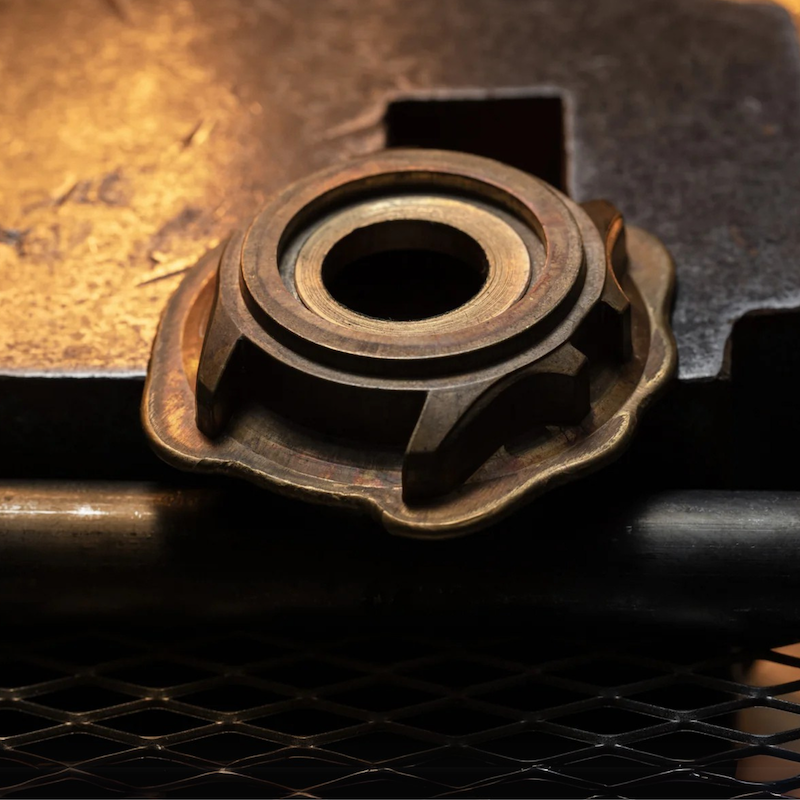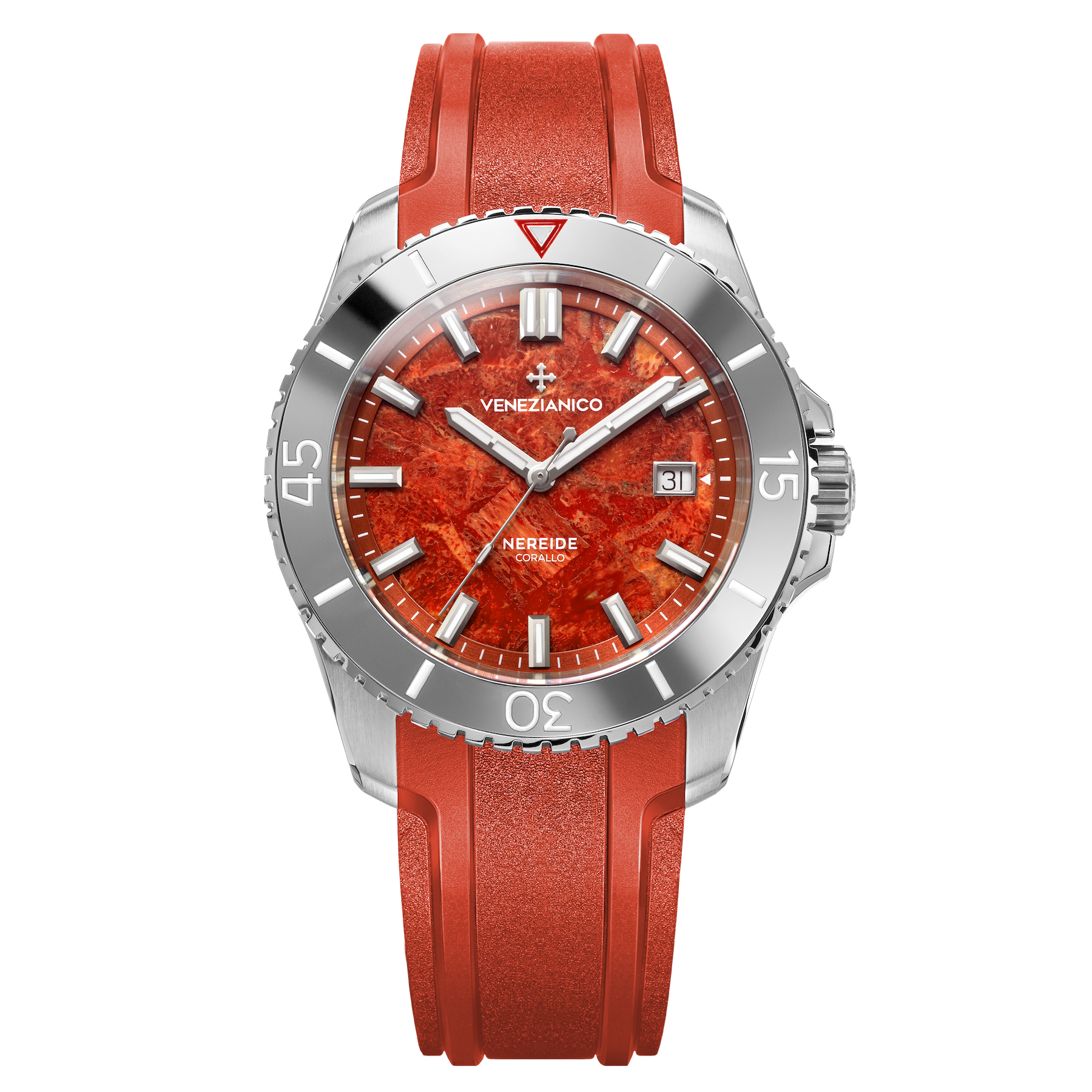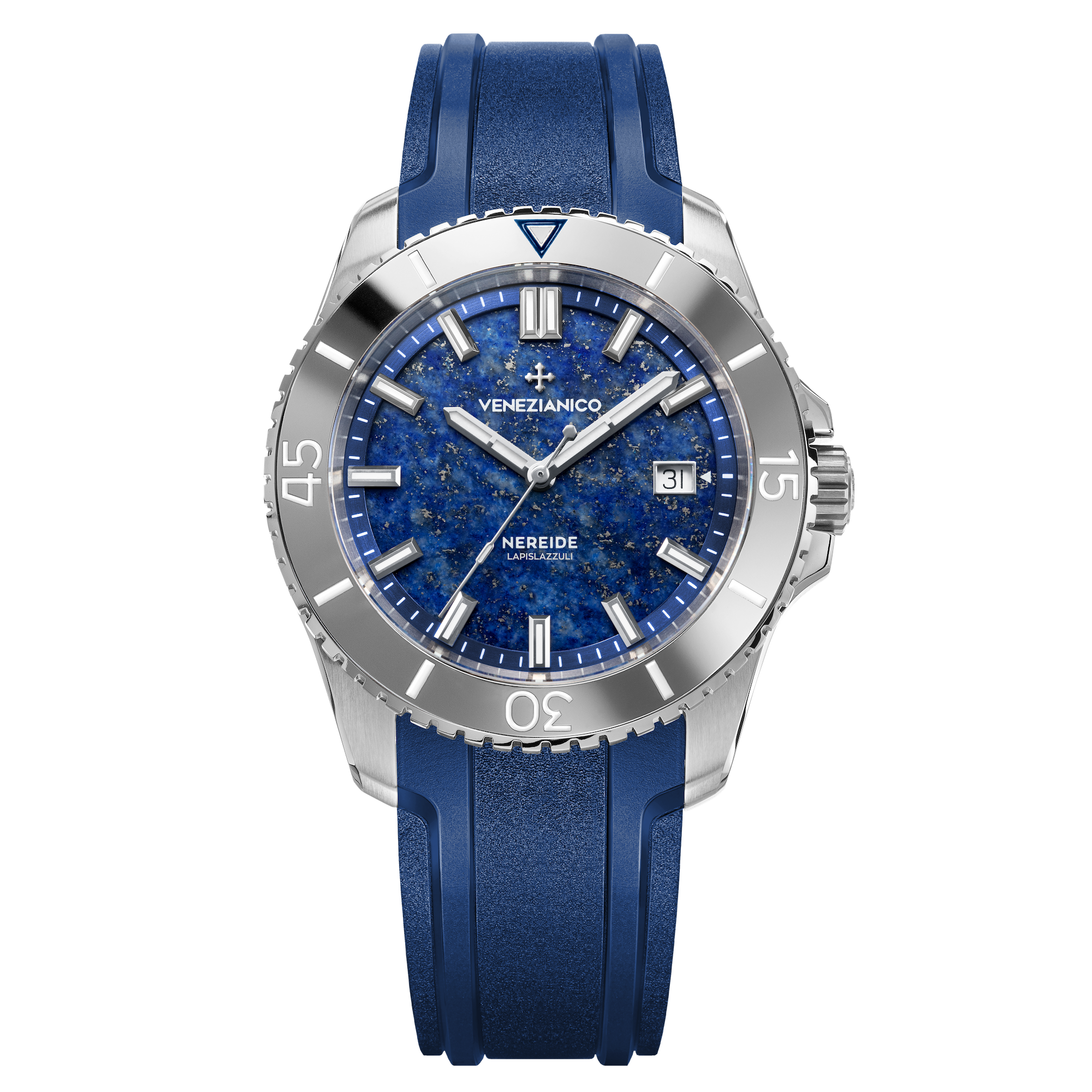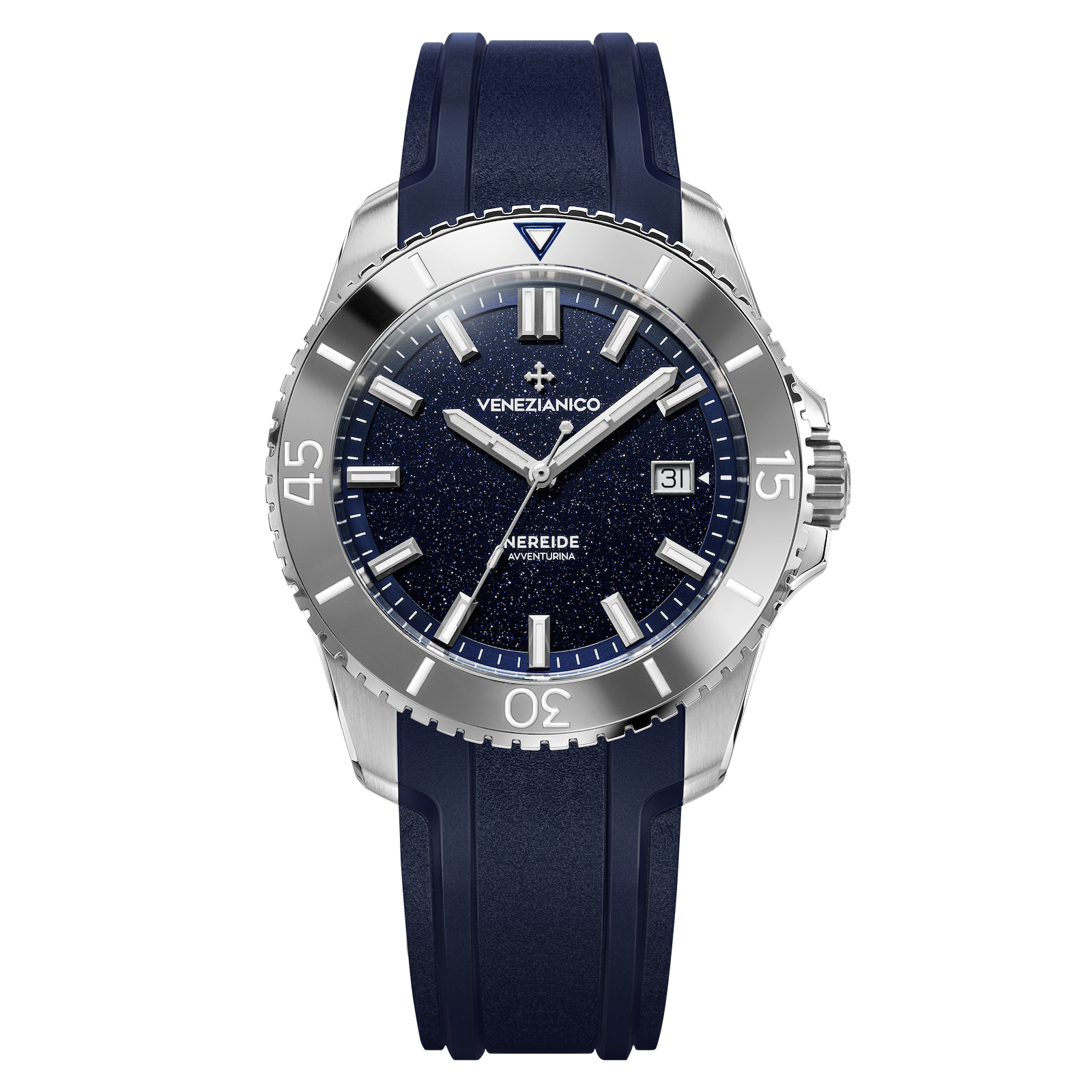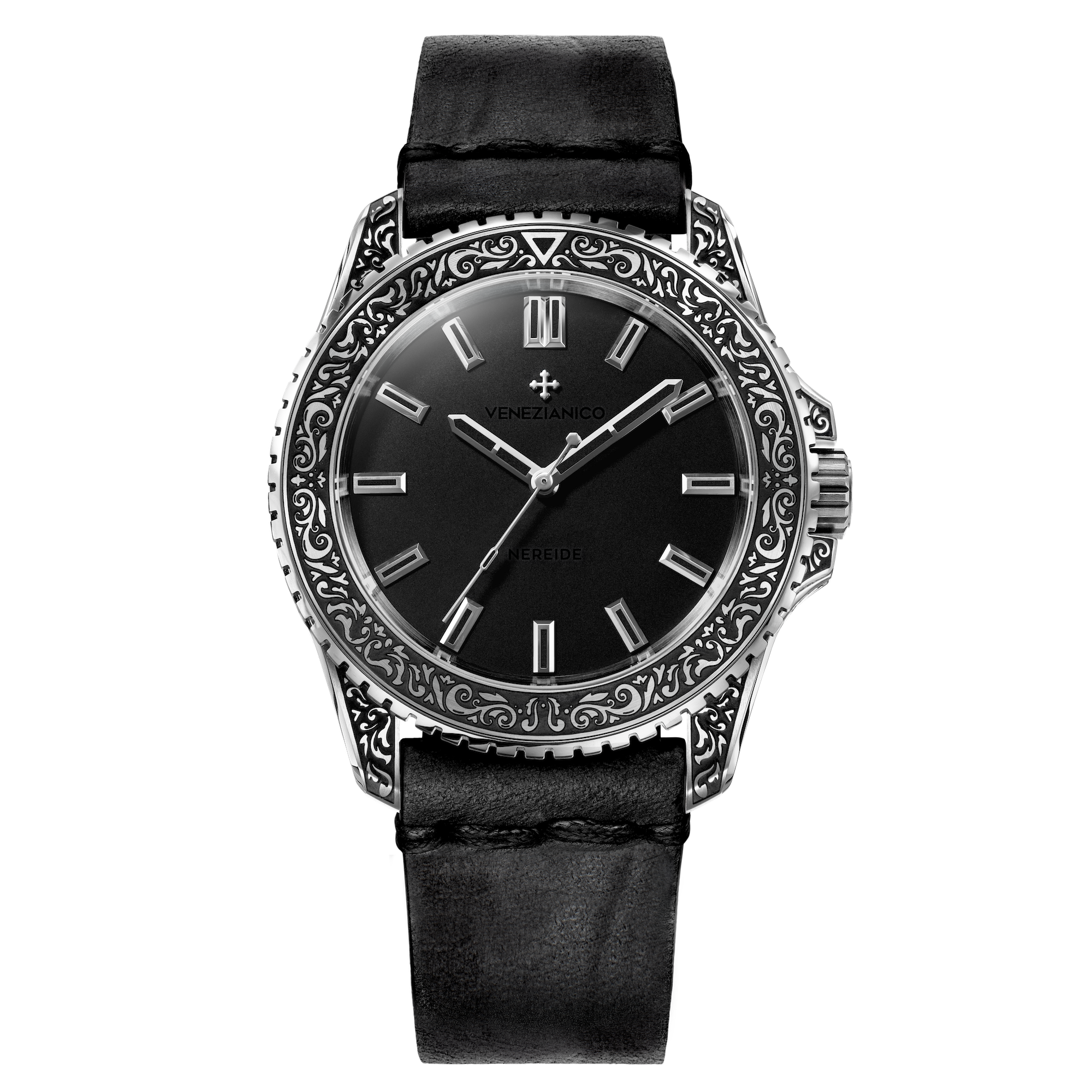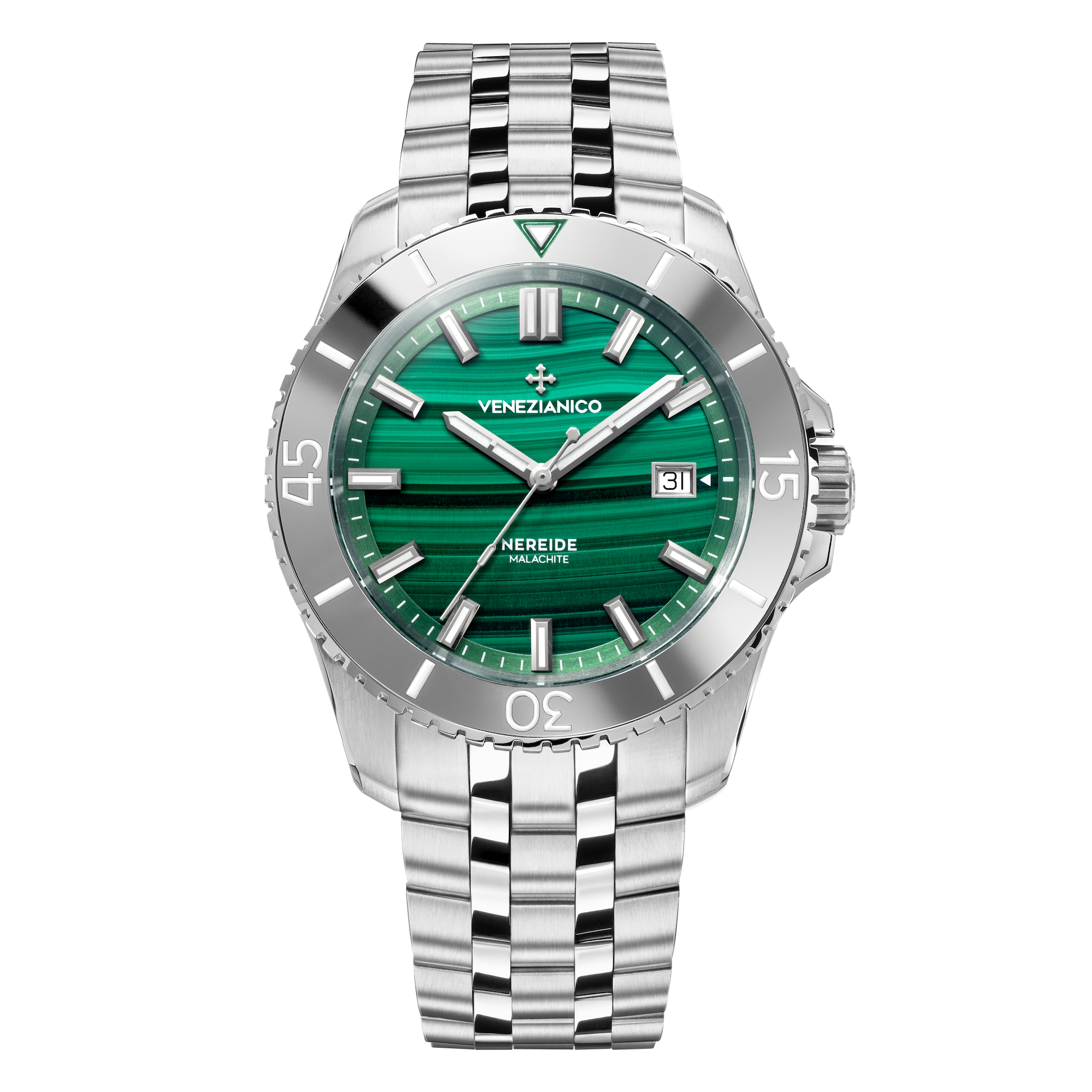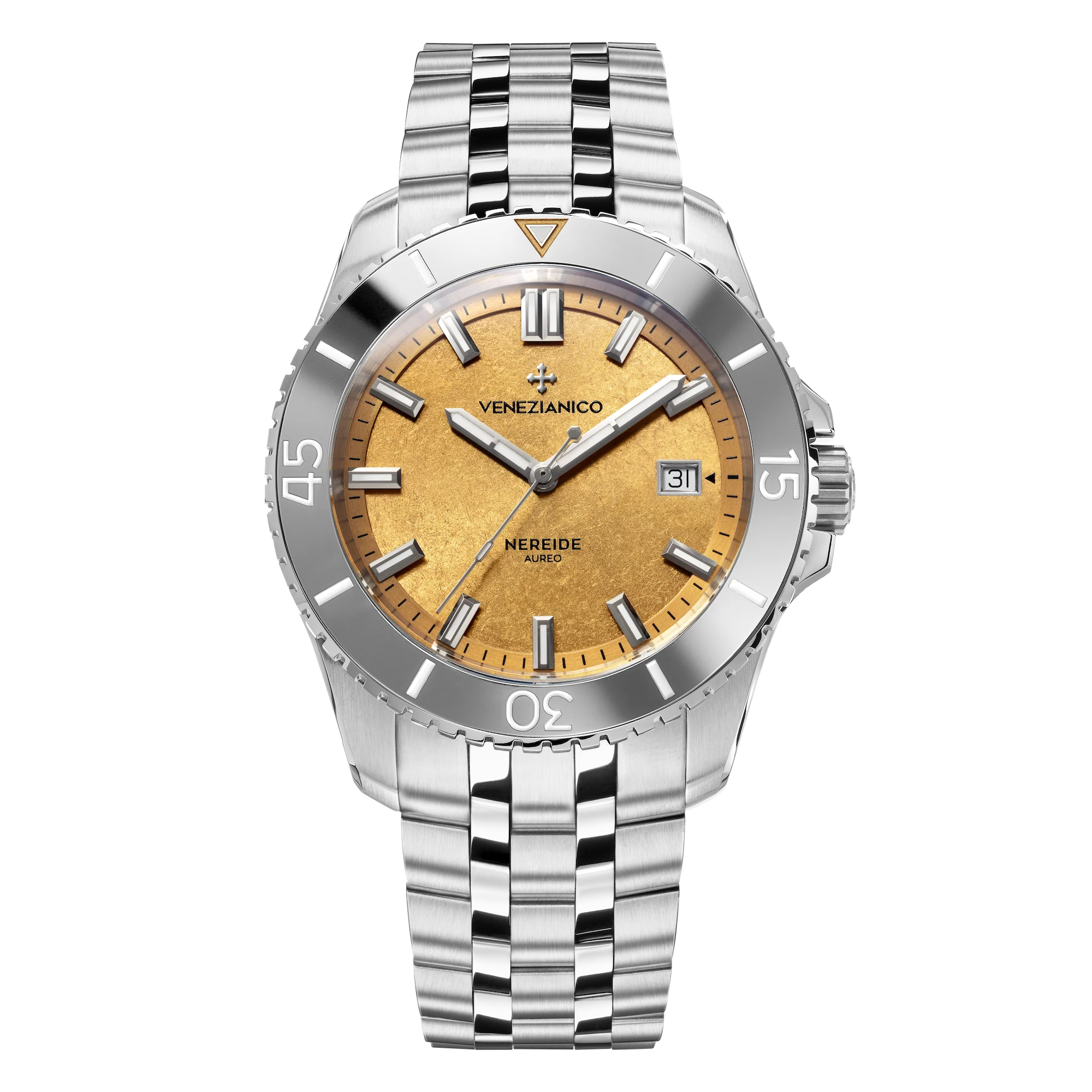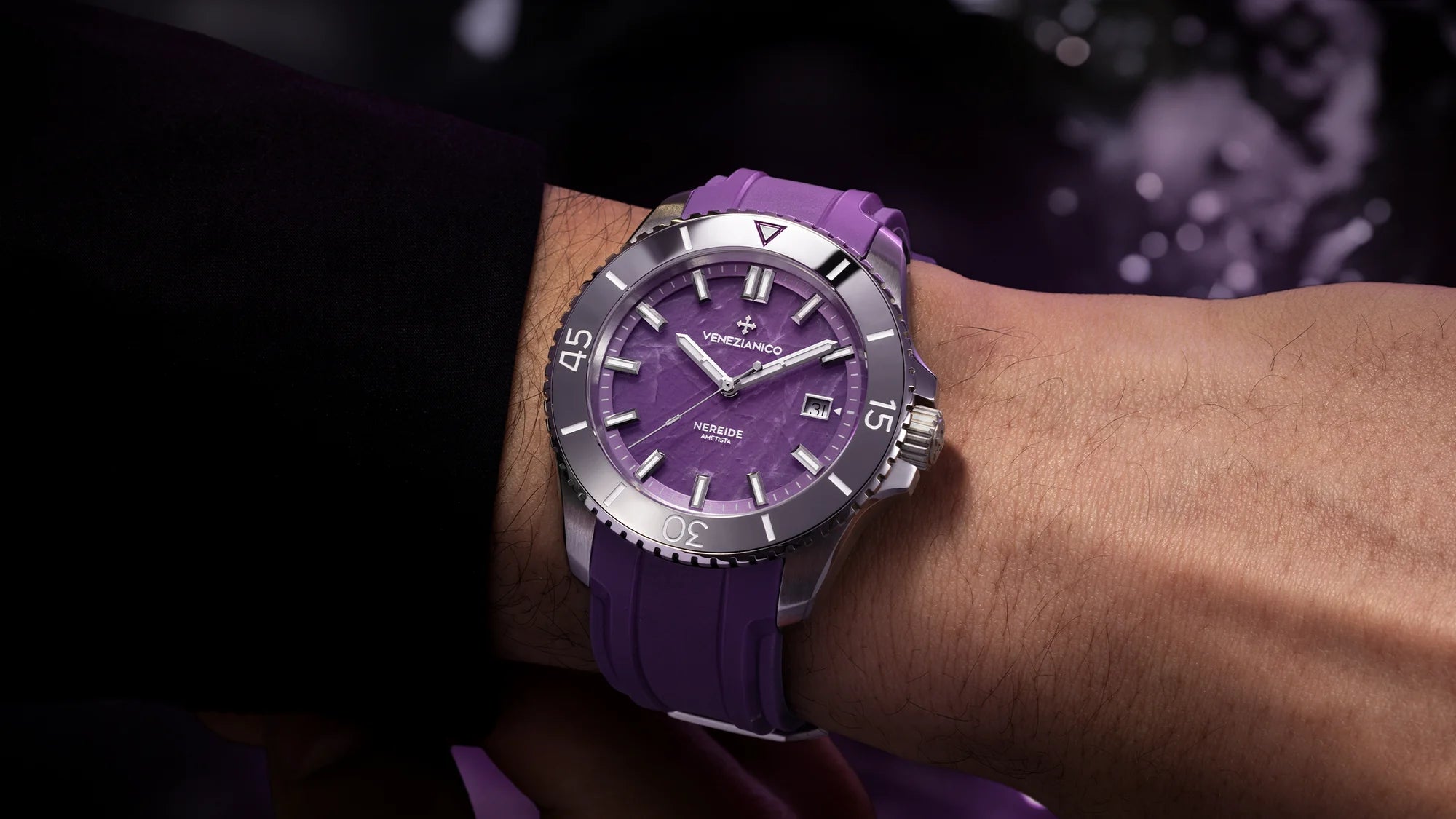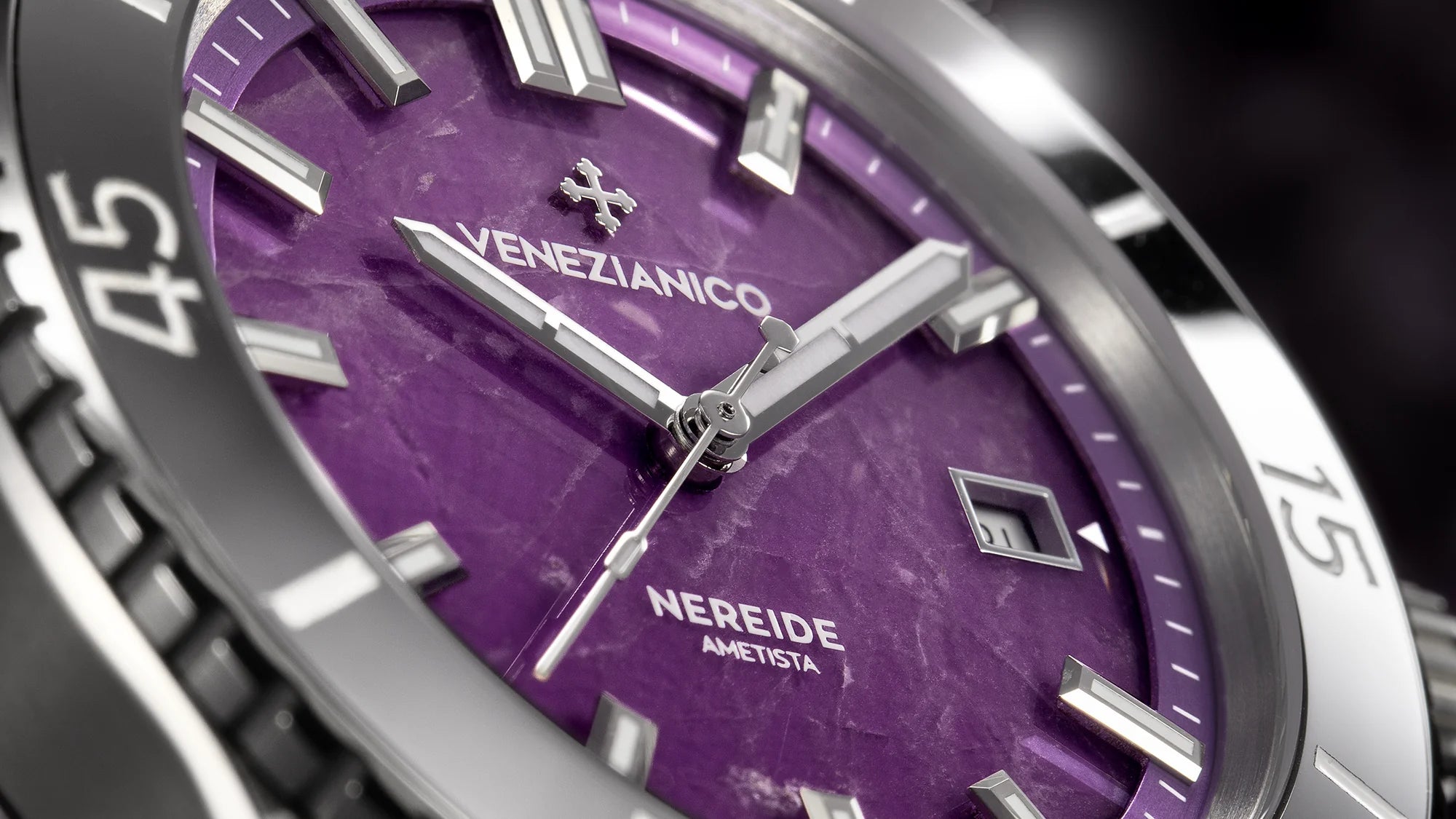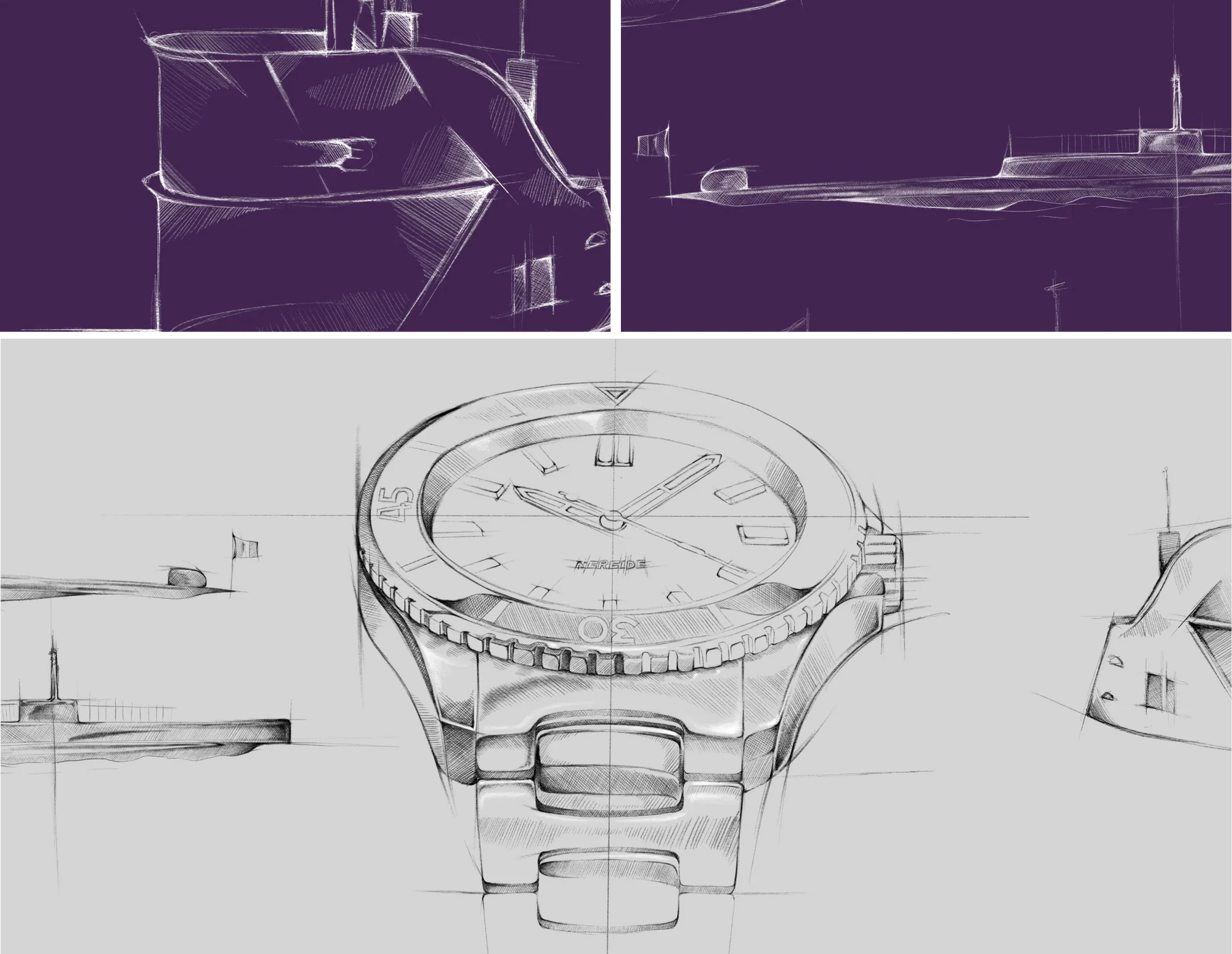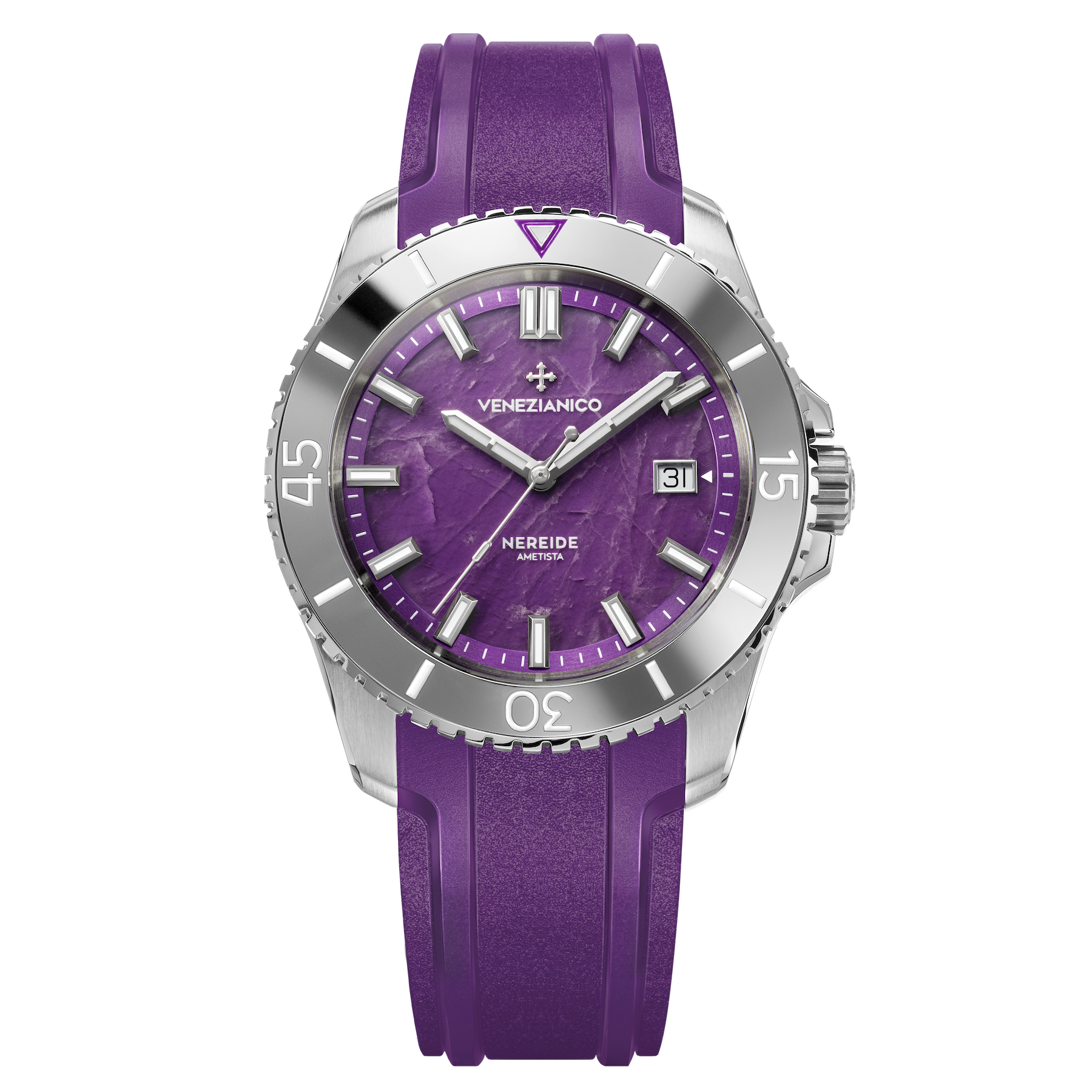
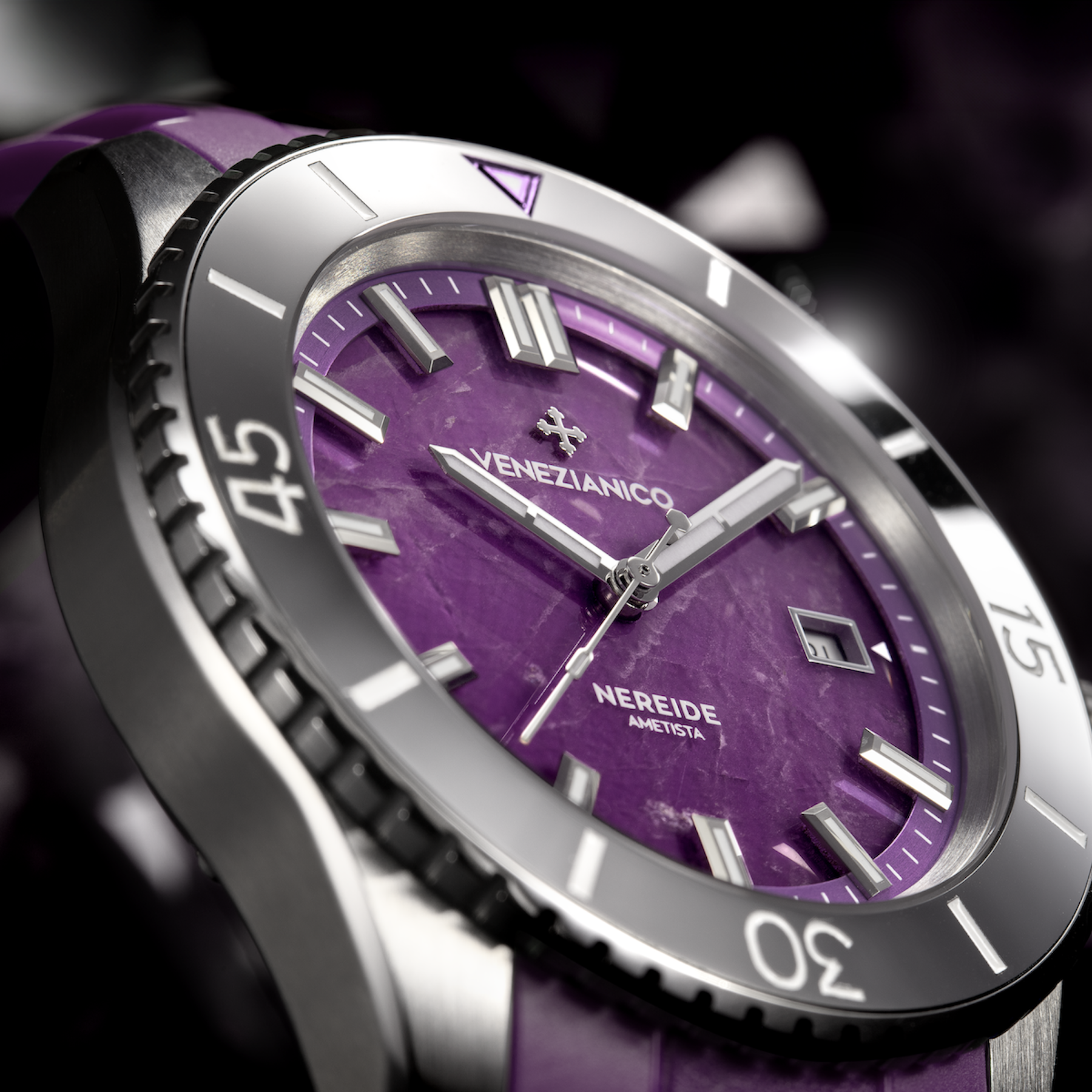
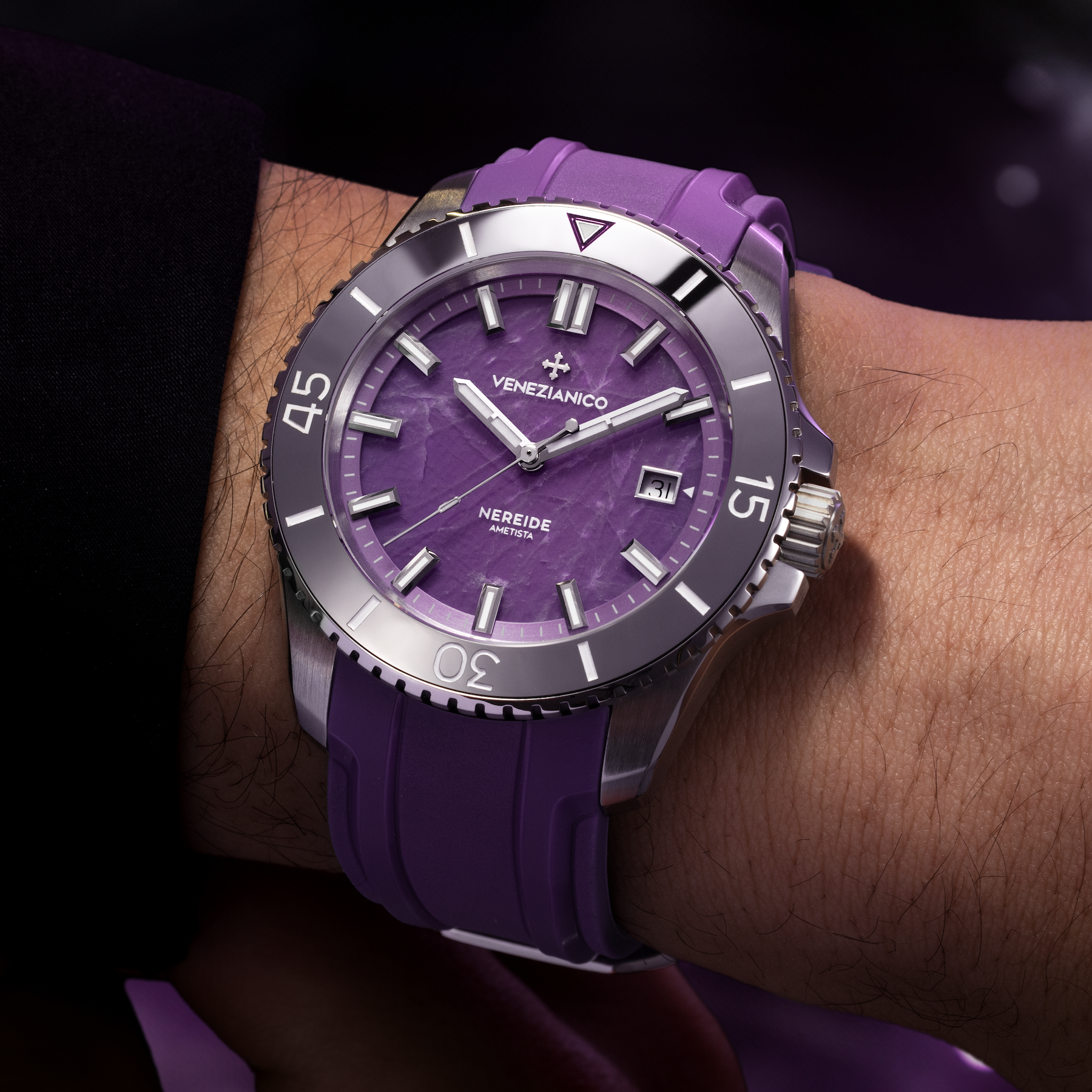
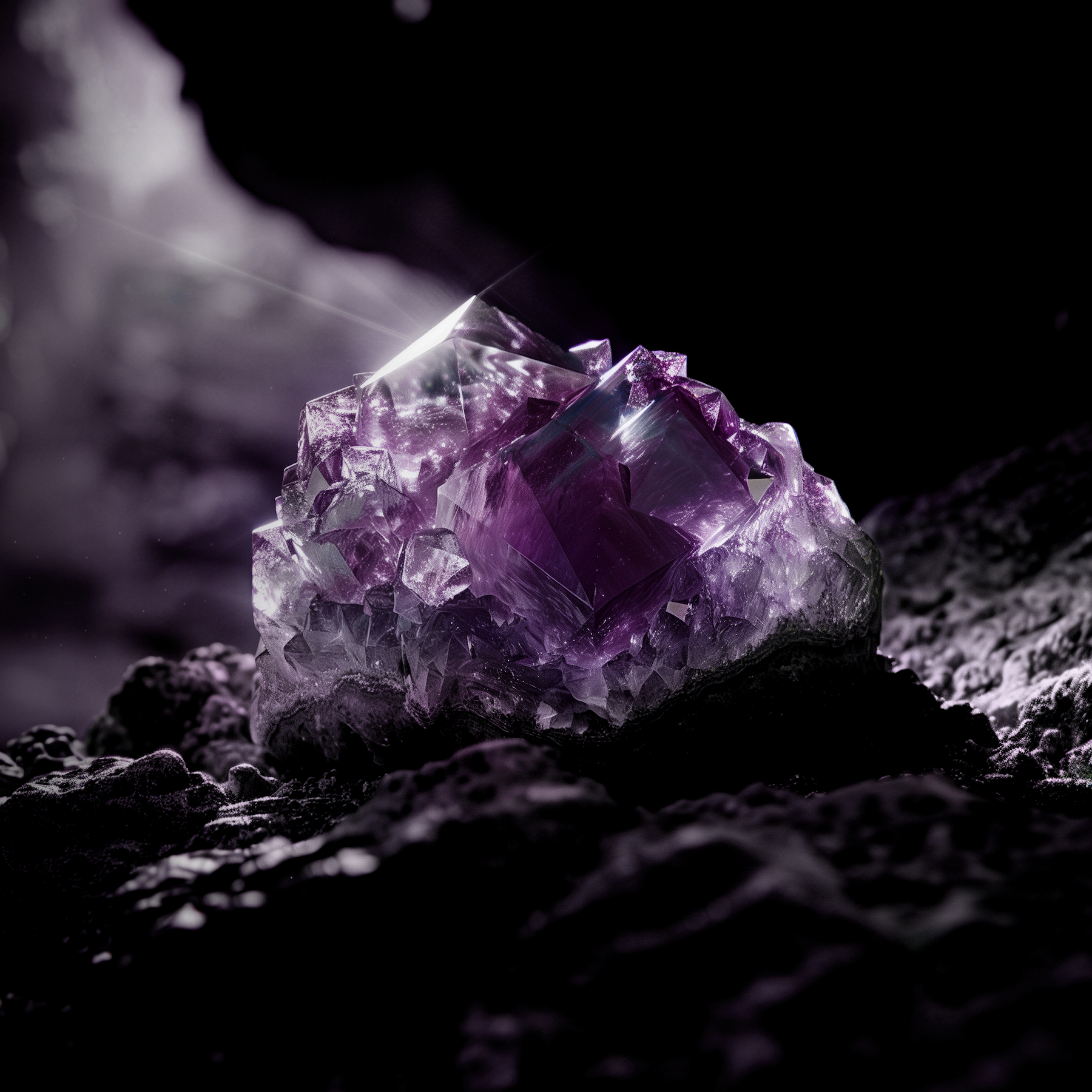
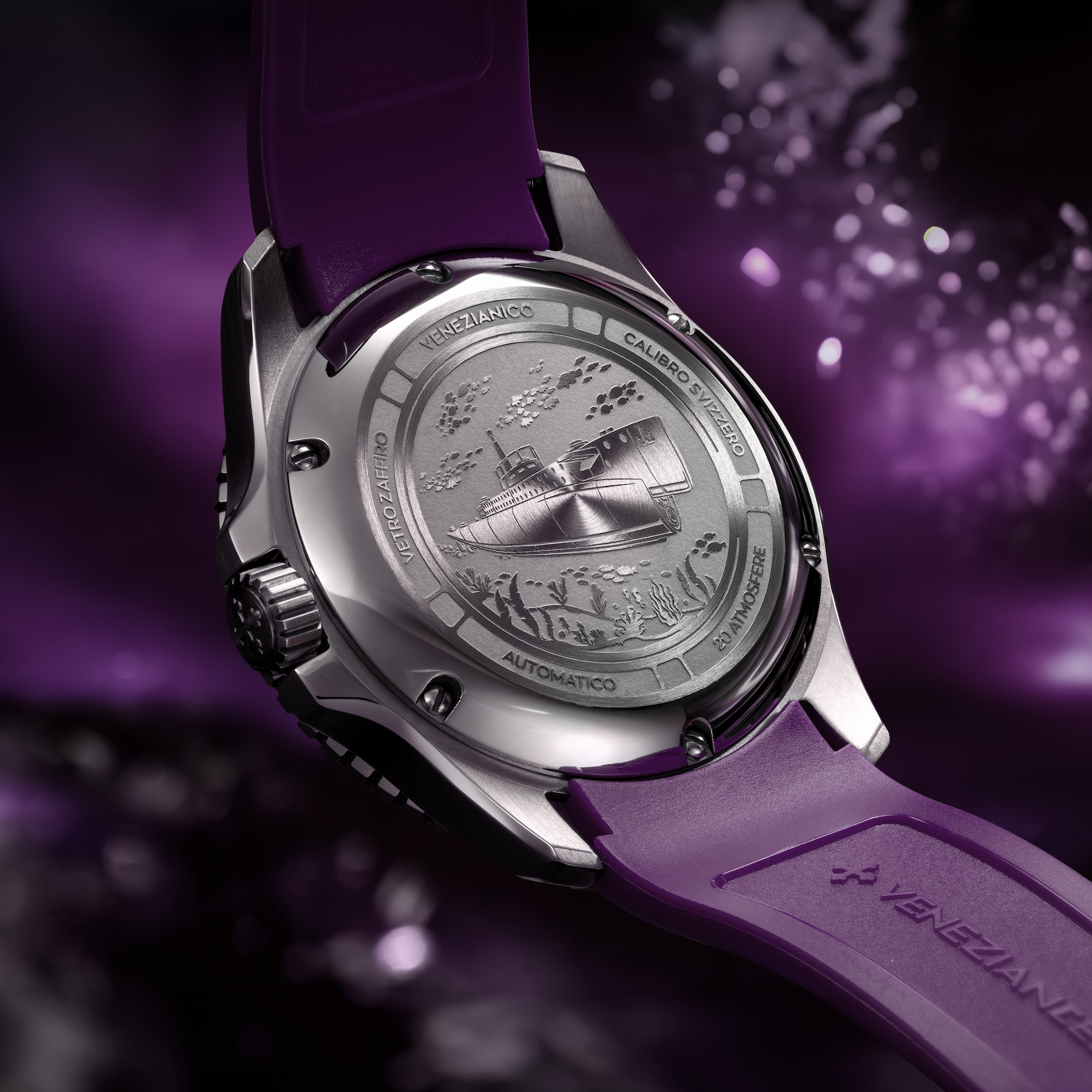
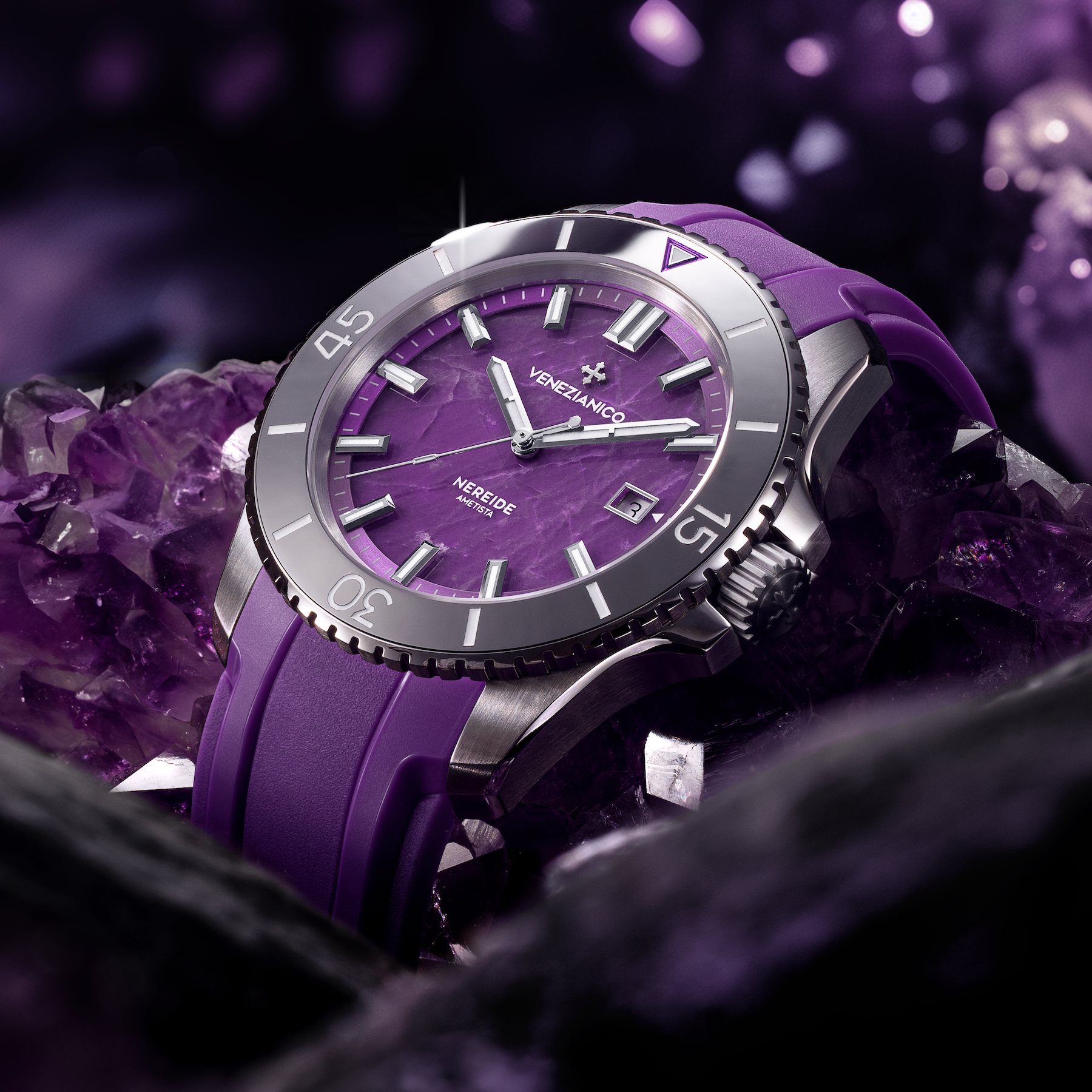
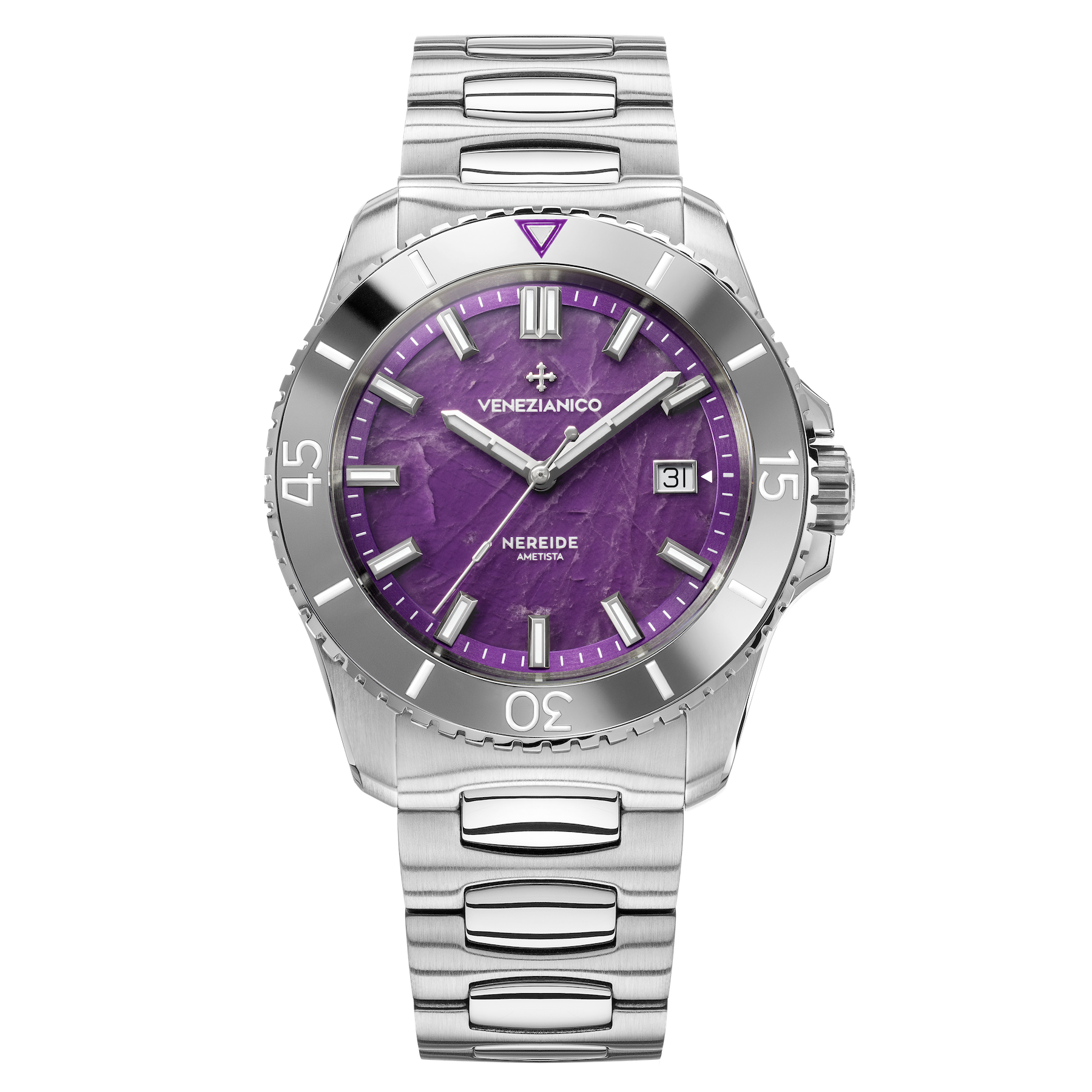

Nereide Ametista - 4521545
 Pay in installments at checkout.
Pay in installments at checkout.
All recent U.S. import tariffs are already included in our prices. With Delivery Duty Paid (DDP) shipping, tariffs, duties and fees are fully covered. The price you see at checkout is exactly what you pay, with no surprises. Enjoy a smooth and worry-free shopping experience.
Nereide Amethyst blends the rich Venetian artisanal tradition with experimentation in contemporary materials. In addition to the precious dial, it stands out for the use of a tungsten bezel, an indestructible metal known for its excellent mechanical properties and durability.
CASE MATERIAL: 316L Stainless Steel
DIAL: Natural Amethyst stone
DIMENSIONS: Ø42mm, lug to lug 49mm, thickness 12.5mm
MOVEMENT: Automatic Cal. Sellita SW200-1 Swiss Made
CRYSTAL: Sapphire Glass with anti-reflective coating
LUMINOUS MATERIAL: BGW9 Super-LumiNova®
BEZEL: Tungsten insert, 120 clicks
CROWN: Screw-Down
WR: 20ATM (= 200mt)
STRAP: Rubber band, Made in Italy
All orders include free shipping. Here are the average delivery times:
- EU Countries: 1-2 business days
- United Kingdom: 2-3 business days
- USA: 2-3 business days
- Other Countries: 2-5 business days
If the watch does not meet expectations, it can be returned within 14 days for a full refund of the purchase amount. For more info, check out our Terms and Conditions.

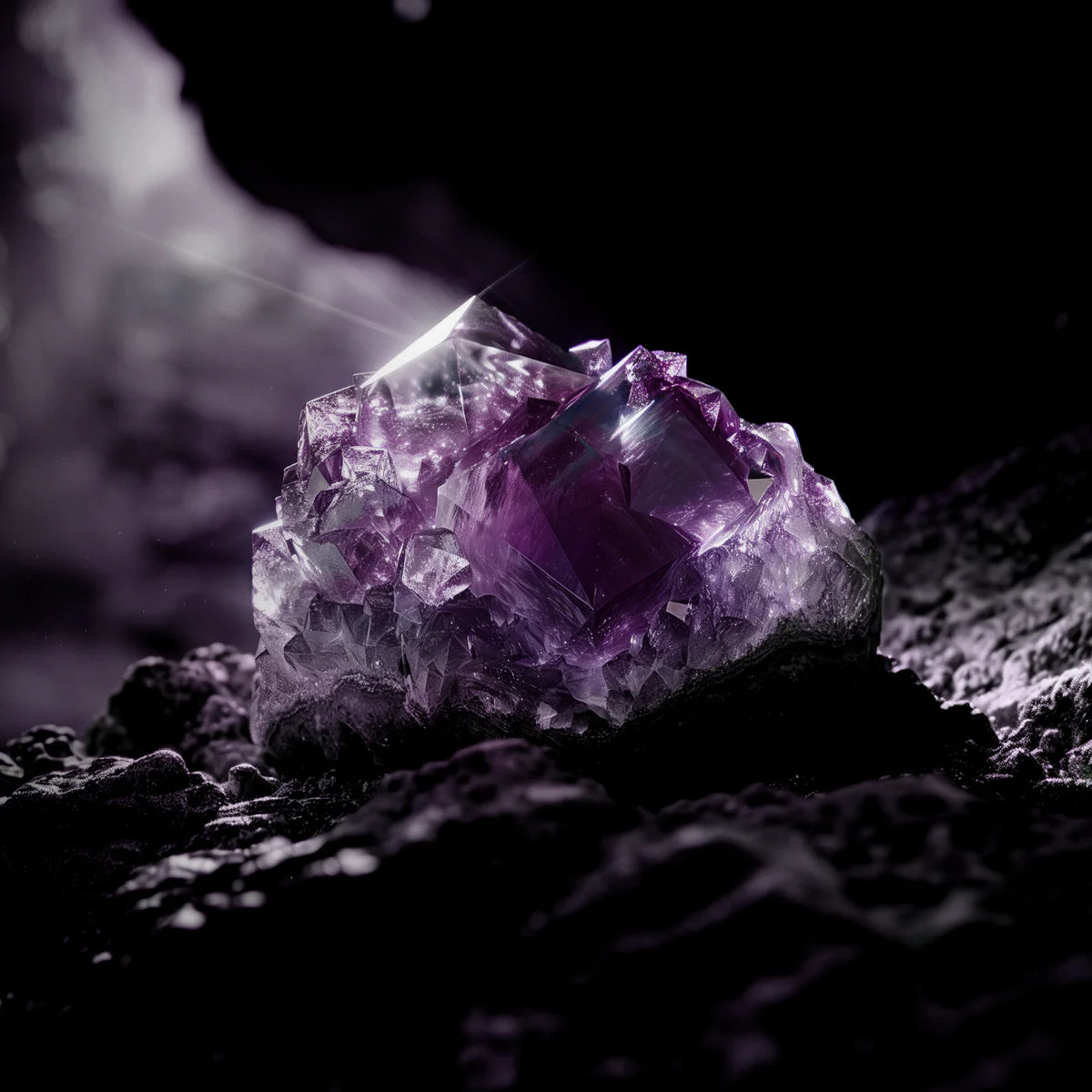
Amethyst is a variety of quartz with a purple color, ranging from light and delicate hues to more intense and deep tones. Its beauty is enhanced by its ability to reflect light delicately, creating a luminous and enveloping effect. Thanks to its unique brilliance and intrinsic elegance, amethyst has been used for centuries in the creation of high-value jewelry and art objects.

During the Middle Ages, Venice became a key center in the trade of gemstones, thanks to its strategic location and connections with the East, including the Byzantine Empire and Arab territories. Amethyst, originating from India and Persia, became particularly prized. With its excellent craftsmanship, Venice transformed amethyst into jewelry and ornaments of immeasurable value, which were not only artistic masterpieces but also tangible symbols of wealth and prestige.
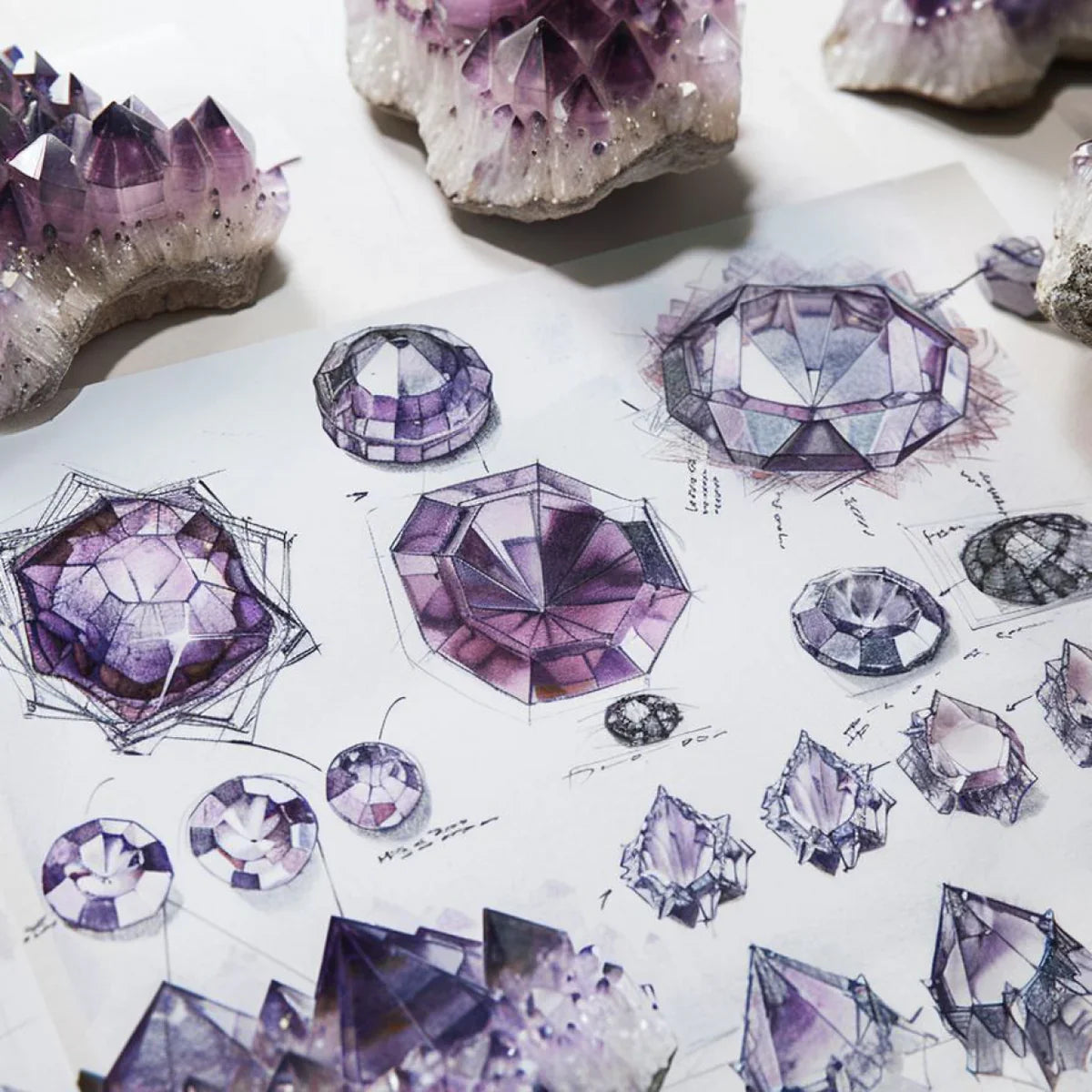
Amethyst, with its refined crystalline structure and deep purple color, presents unique specificities and challenges in the craftsmanship process, which favors cold cutting. Through this technique, amethyst is shaped into various forms and sizes, such as brilliant, oval, pear, or cabochon, aiming to enhance its brightness and chromatic tone. Subsequently, the polishing phase begins, where fine-grit abrasives and polishing compounds are used to give the stone an impeccable and uniform surface.
Amethyst is a variety of quartz with a purple color, ranging from light and delicate hues to more intense and deep tones. Its beauty is enhanced by its ability to reflect light delicately, creating a luminous and enveloping effect. Thanks to its unique brilliance and intrinsic elegance, amethyst has been used for centuries in the creation of high-value jewelry and art objects.
During the Middle Ages, Venice became a key center in the trade of gemstones, thanks to its strategic location and connections with the East, including the Byzantine Empire and Arab territories. Amethyst, originating from India and Persia, became particularly prized. With its excellent craftsmanship, Venice transformed amethyst into jewelry and ornaments of immeasurable value, which were not only artistic masterpieces but also tangible symbols of wealth and prestige.
Amethyst, with its refined crystalline structure and deep purple color, presents unique specificities and challenges in the craftsmanship process, which favors cold cutting. Through this technique, amethyst is shaped into various forms and sizes, such as brilliant, oval, pear, or cabochon, aiming to enhance its brightness and chromatic tone. Subsequently, the polishing phase begins, where fine-grit abrasives and polishing compounds are used to give the stone an impeccable and uniform surface.



Technical details
Our dive watch, water-resistant to a depth of 200 meters, takes its name from the Nereide submarine, a marvel of Venetian naval technology. This timepiece is engineered to endure strong stresses, making it particularly well-suited for water sports enthusiasts.
Ø42 mm, lug-to-lug 49 mm, total thickness 12.5 mm
Swiss Made Sellita SW200-1 Automatic, 3 Hands with Date Function
316L Stainless Steel
Tungsten, Polished and Scratch-Resistant with a Hardness of 9/10 on the Mohs Scale
Natural Amethyst Stone, Precision-Cut 0.4mm Layer on brass base
Sapphire with anti-reflective coating
Swiss-Made BGW9 Super-LumiNova®
20 Atmospheres (200m/656ft)
Screw-Down
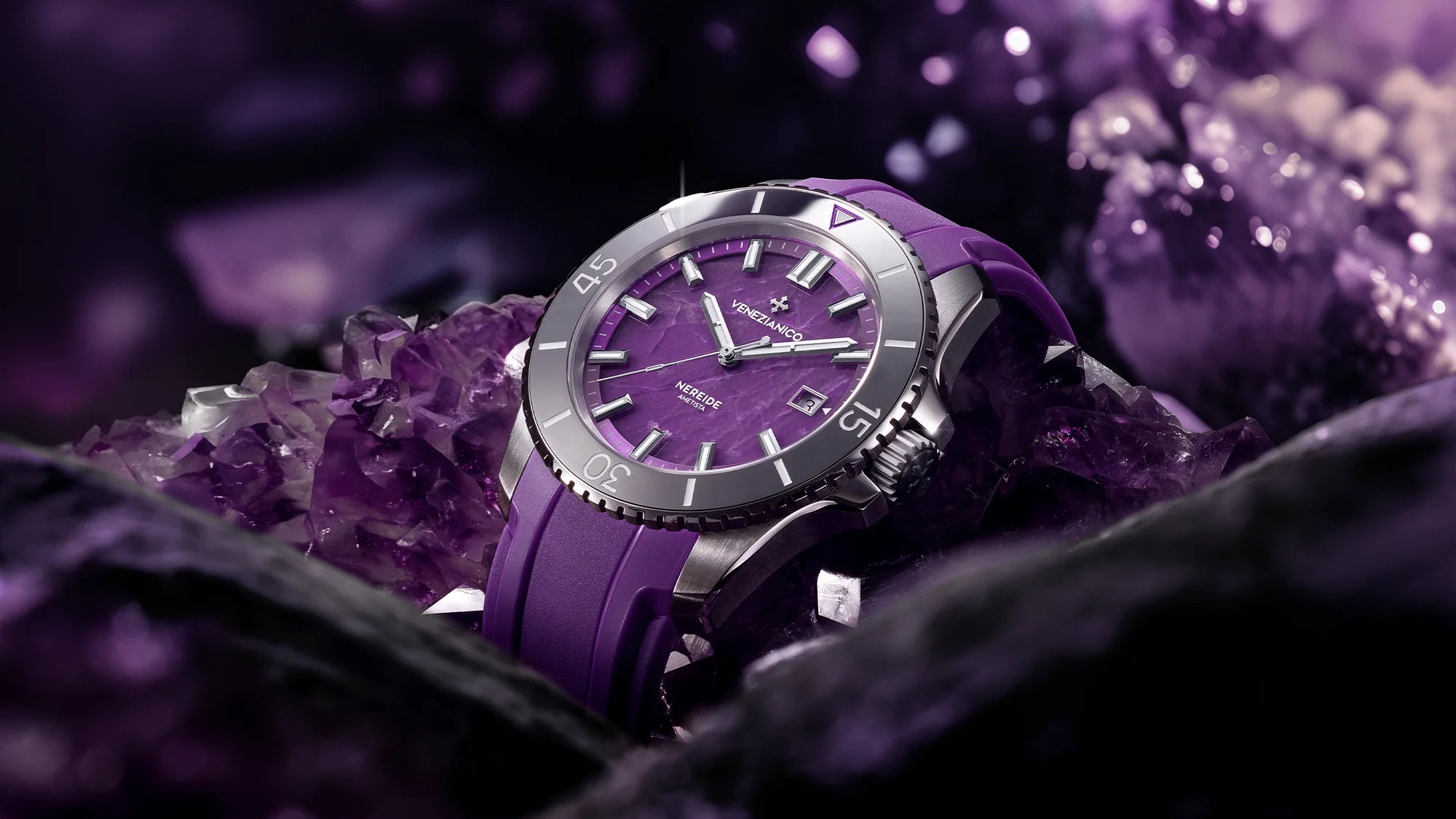
Tungsten Bezel Insert
Tungsten is the hardest and most resistant metal known to mankind.
It has a melting point of 3400°C, which makes it the most heat resistant metal. Its resistance to wear is equally incredible. Tungsten is, in practice, scratchproof and therefore it maintains its physical and aesthetic features unchanged over the years.
Amethyst Dial
The production of a dial follows a procedure similar to the one described previously, but introduces additional complexity: the delicate cutting of an amethyst disk only 0.4 mm thick. This operation requires exceptional precision and careful control of the tools, given the intrinsic fragility of the stone and its predisposition to chipping. Once these stages are completed, the dial is carefully assembled by specialized artisans.
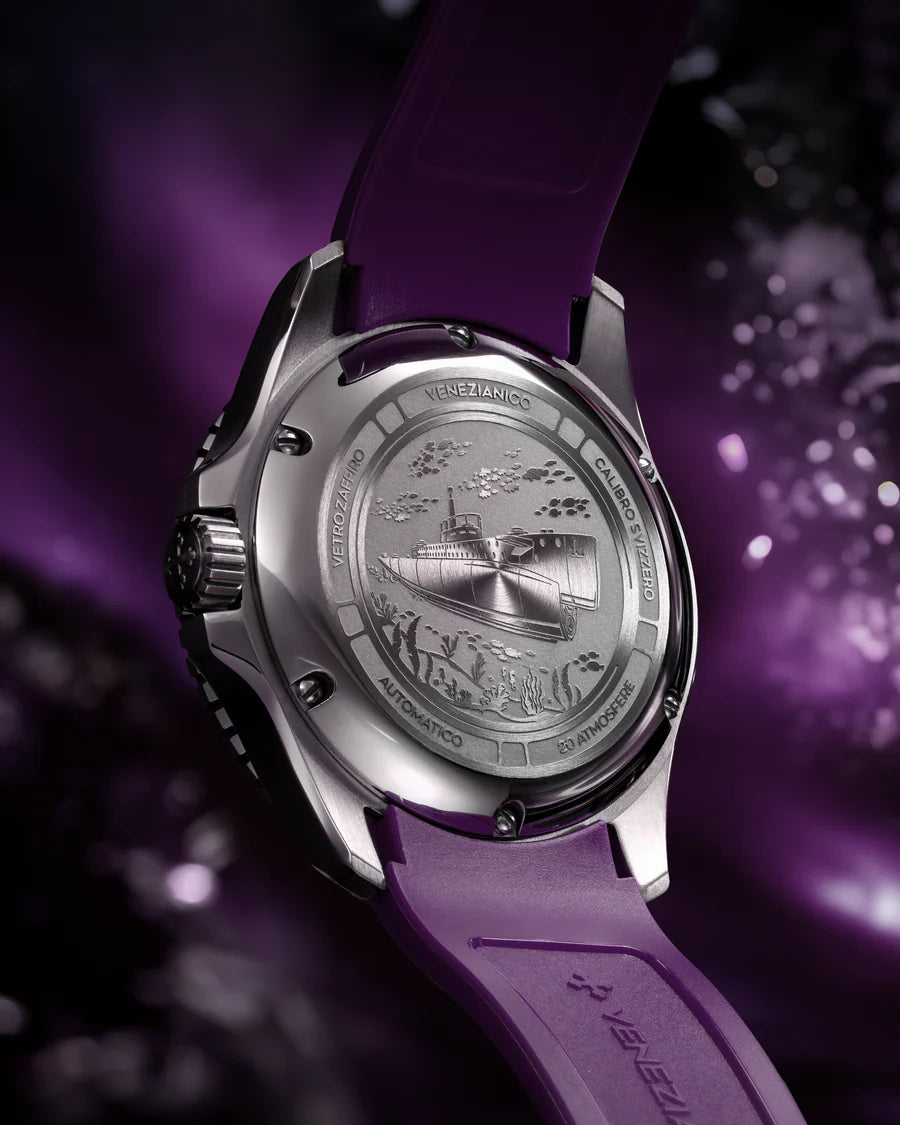
The submarine Nereide, which inspires the entire collection, is depicted submerged in the engraving at the center of the caseback, to remind how this watch doesn't compromise on underwater performance, retaining the ability to dive up to 200m deep and the rotating bezel that allows monitoring of dive times.
The Essence of Venice
Wearing a watch with an amethyst dial is an experience that deeply connects us to the elegance and history of Venice. Every time we raise our wrist to check the time, we find ourselves immersed in the richness of a centuries-old cultural heritage, a narrative of distant trades, craftsmanship, and a gem that has enchanted generations. The reflections and deep hues of amethyst transport us on a journey through Venetian history, highlighting the city's ability to enhance the natural beauty of this extraordinary stone.

Sansovino Bracelet
The Nereide Ametista is also available with our second bracelet inspired by the works of Renaissance sculptor Jacopo Sansovino, known for his mastery and attention to detail. Composed of five links—two polished and three satin-finished—it offers a perfect balance of elegance and robustness. The solid closure, with dual finish and micro-adjustment, ensures a comfortable and secure fit, ideal for diving enthusiasts.


